Impact of Reward Systems on Employee Performance: Marriott Case Study
VerifiedAdded on 2019/12/03
|9
|2189
|187
Project
AI Summary
This project is a proposal to assess the impact of reward systems on employee performance, specifically using Marriott as a case study. The introduction highlights the importance of employees as key assets for organizational success and the significance of motivation, rewards, and recognition in driving performance. The research issue focuses on the dynamic and competitive business environment, emphasizing the need for companies to understand employee motivation. The study aims to investigate the impact of both intrinsic and extrinsic rewards on employee performance, identify effective reward methods, and assess the importance of reward systems for companies. The project includes a detailed literature review covering rewards and total reward systems, followed by a research methodology section outlining the research philosophy (realism), approach (inductive), strategy (case study), data collection methods (primary and secondary), data analysis plan (SPSS), sampling, and considerations for validity and reliability. The project is structured to provide a comprehensive analysis of how reward systems influence employee performance within a specific organizational context.
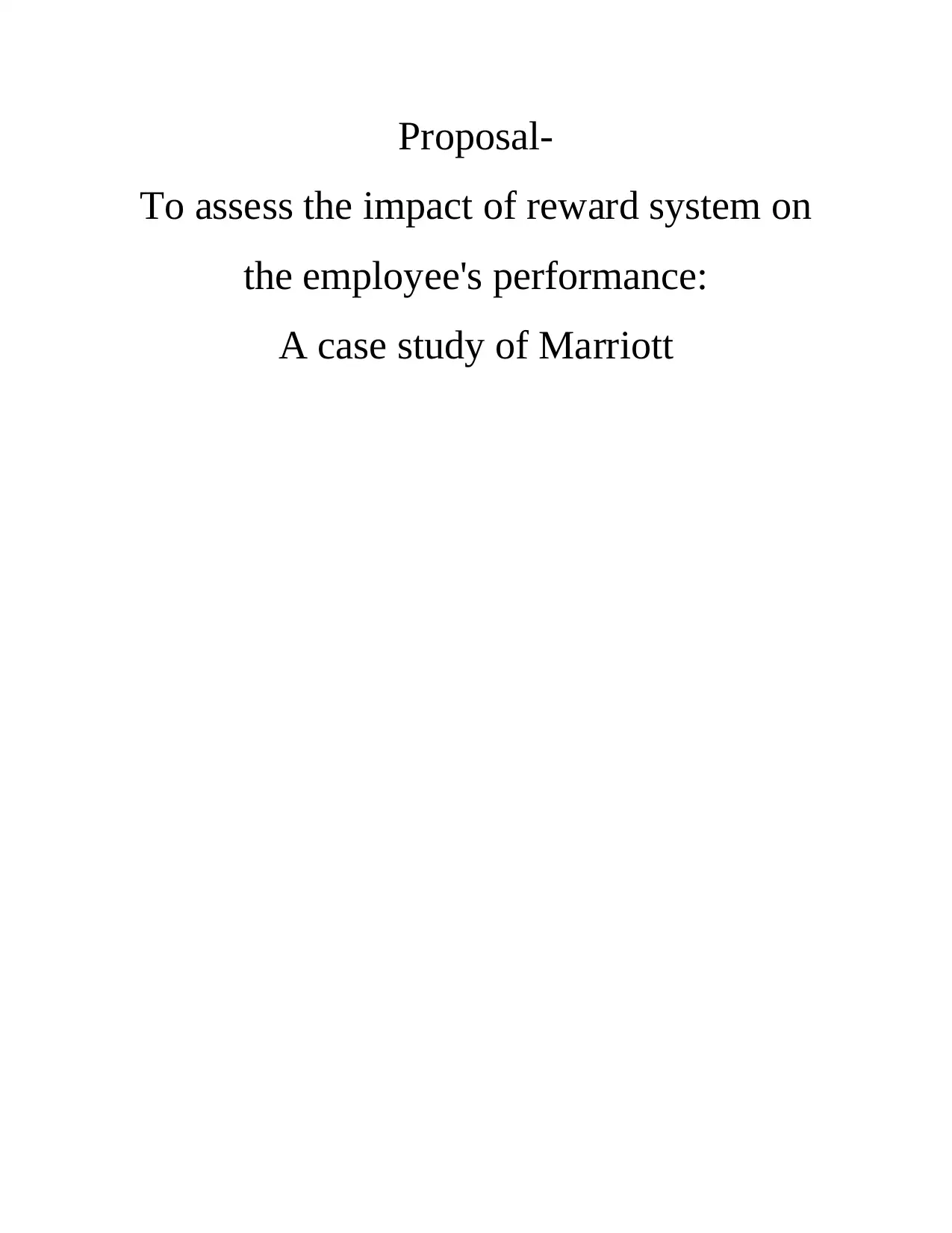
Proposal-
To assess the impact of reward system on
the employee's performance:
A case study of Marriott
To assess the impact of reward system on
the employee's performance:
A case study of Marriott
Paraphrase This Document
Need a fresh take? Get an instant paraphrase of this document with our AI Paraphraser
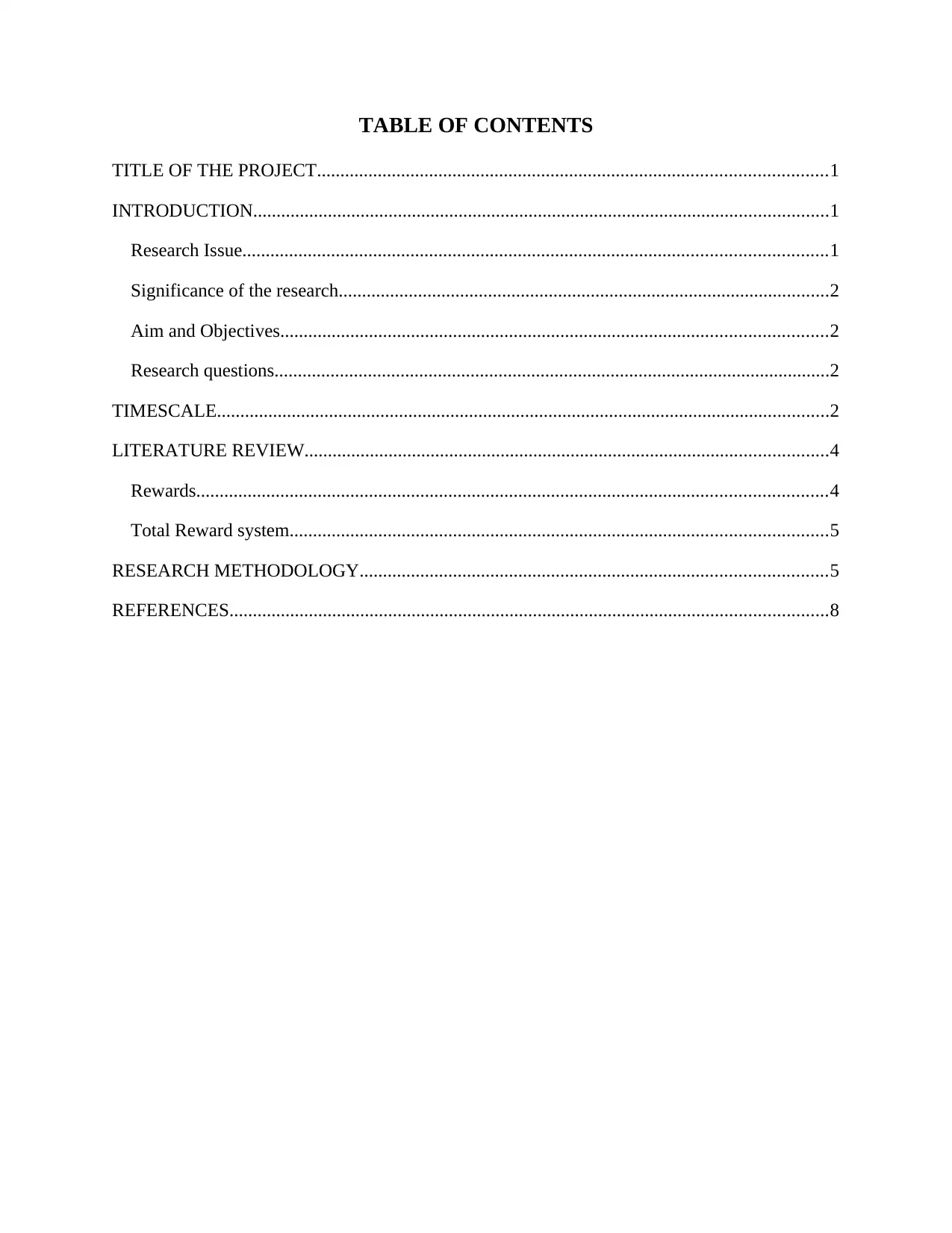
TABLE OF CONTENTS
TITLE OF THE PROJECT.............................................................................................................1
INTRODUCTION...........................................................................................................................1
Research Issue.............................................................................................................................1
Significance of the research.........................................................................................................2
Aim and Objectives.....................................................................................................................2
Research questions.......................................................................................................................2
TIMESCALE...................................................................................................................................2
LITERATURE REVIEW................................................................................................................4
Rewards.......................................................................................................................................4
Total Reward system...................................................................................................................5
RESEARCH METHODOLOGY....................................................................................................5
REFERENCES................................................................................................................................8
TITLE OF THE PROJECT.............................................................................................................1
INTRODUCTION...........................................................................................................................1
Research Issue.............................................................................................................................1
Significance of the research.........................................................................................................2
Aim and Objectives.....................................................................................................................2
Research questions.......................................................................................................................2
TIMESCALE...................................................................................................................................2
LITERATURE REVIEW................................................................................................................4
Rewards.......................................................................................................................................4
Total Reward system...................................................................................................................5
RESEARCH METHODOLOGY....................................................................................................5
REFERENCES................................................................................................................................8
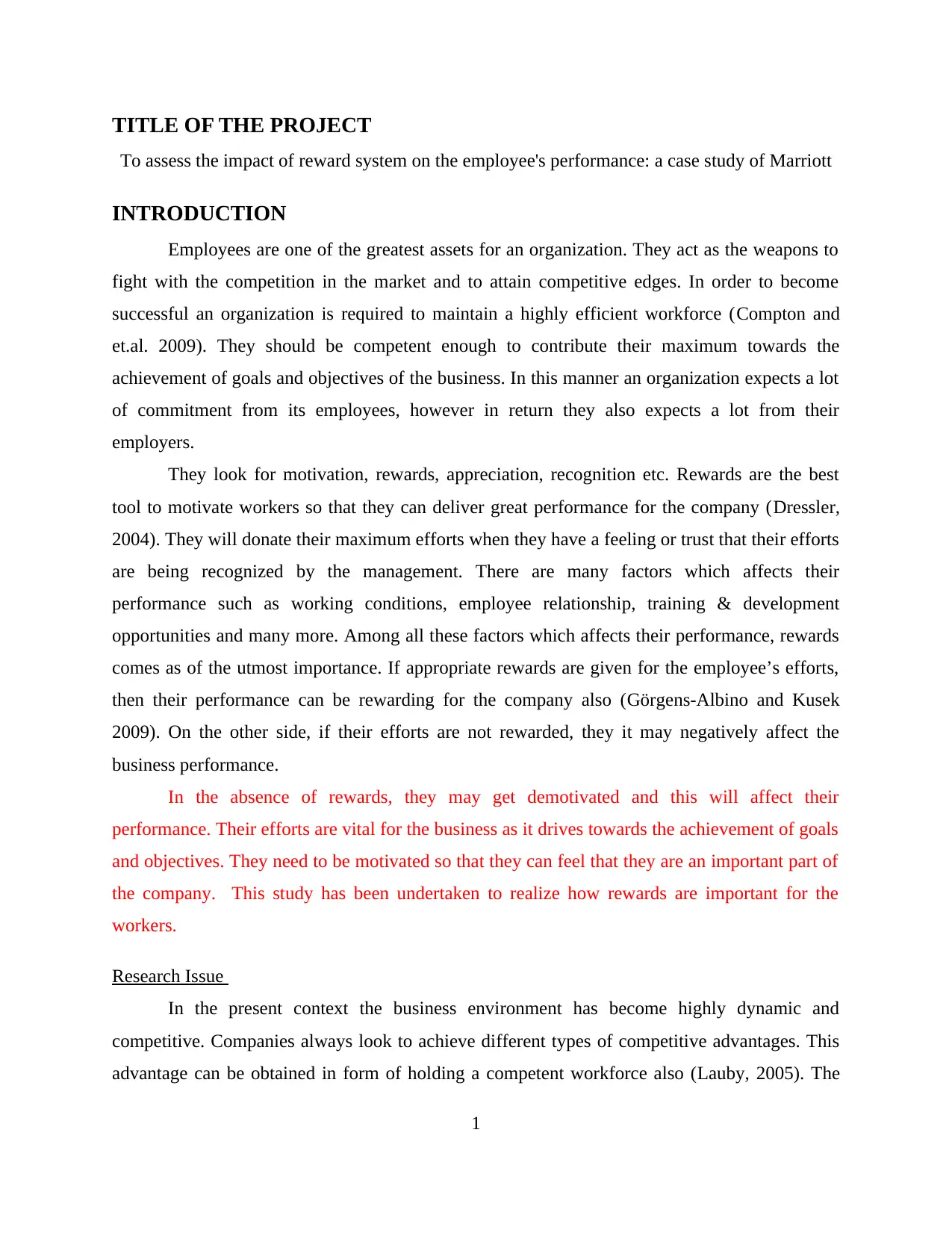
TITLE OF THE PROJECT
To assess the impact of reward system on the employee's performance: a case study of Marriott
INTRODUCTION
Employees are one of the greatest assets for an organization. They act as the weapons to
fight with the competition in the market and to attain competitive edges. In order to become
successful an organization is required to maintain a highly efficient workforce (Compton and
et.al. 2009). They should be competent enough to contribute their maximum towards the
achievement of goals and objectives of the business. In this manner an organization expects a lot
of commitment from its employees, however in return they also expects a lot from their
employers.
They look for motivation, rewards, appreciation, recognition etc. Rewards are the best
tool to motivate workers so that they can deliver great performance for the company (Dressler,
2004). They will donate their maximum efforts when they have a feeling or trust that their efforts
are being recognized by the management. There are many factors which affects their
performance such as working conditions, employee relationship, training & development
opportunities and many more. Among all these factors which affects their performance, rewards
comes as of the utmost importance. If appropriate rewards are given for the employee’s efforts,
then their performance can be rewarding for the company also (Görgens-Albino and Kusek
2009). On the other side, if their efforts are not rewarded, they it may negatively affect the
business performance.
In the absence of rewards, they may get demotivated and this will affect their
performance. Their efforts are vital for the business as it drives towards the achievement of goals
and objectives. They need to be motivated so that they can feel that they are an important part of
the company. This study has been undertaken to realize how rewards are important for the
workers.
Research Issue
In the present context the business environment has become highly dynamic and
competitive. Companies always look to achieve different types of competitive advantages. This
advantage can be obtained in form of holding a competent workforce also (Lauby, 2005). The
1
To assess the impact of reward system on the employee's performance: a case study of Marriott
INTRODUCTION
Employees are one of the greatest assets for an organization. They act as the weapons to
fight with the competition in the market and to attain competitive edges. In order to become
successful an organization is required to maintain a highly efficient workforce (Compton and
et.al. 2009). They should be competent enough to contribute their maximum towards the
achievement of goals and objectives of the business. In this manner an organization expects a lot
of commitment from its employees, however in return they also expects a lot from their
employers.
They look for motivation, rewards, appreciation, recognition etc. Rewards are the best
tool to motivate workers so that they can deliver great performance for the company (Dressler,
2004). They will donate their maximum efforts when they have a feeling or trust that their efforts
are being recognized by the management. There are many factors which affects their
performance such as working conditions, employee relationship, training & development
opportunities and many more. Among all these factors which affects their performance, rewards
comes as of the utmost importance. If appropriate rewards are given for the employee’s efforts,
then their performance can be rewarding for the company also (Görgens-Albino and Kusek
2009). On the other side, if their efforts are not rewarded, they it may negatively affect the
business performance.
In the absence of rewards, they may get demotivated and this will affect their
performance. Their efforts are vital for the business as it drives towards the achievement of goals
and objectives. They need to be motivated so that they can feel that they are an important part of
the company. This study has been undertaken to realize how rewards are important for the
workers.
Research Issue
In the present context the business environment has become highly dynamic and
competitive. Companies always look to achieve different types of competitive advantages. This
advantage can be obtained in form of holding a competent workforce also (Lauby, 2005). The
1
⊘ This is a preview!⊘
Do you want full access?
Subscribe today to unlock all pages.

Trusted by 1+ million students worldwide
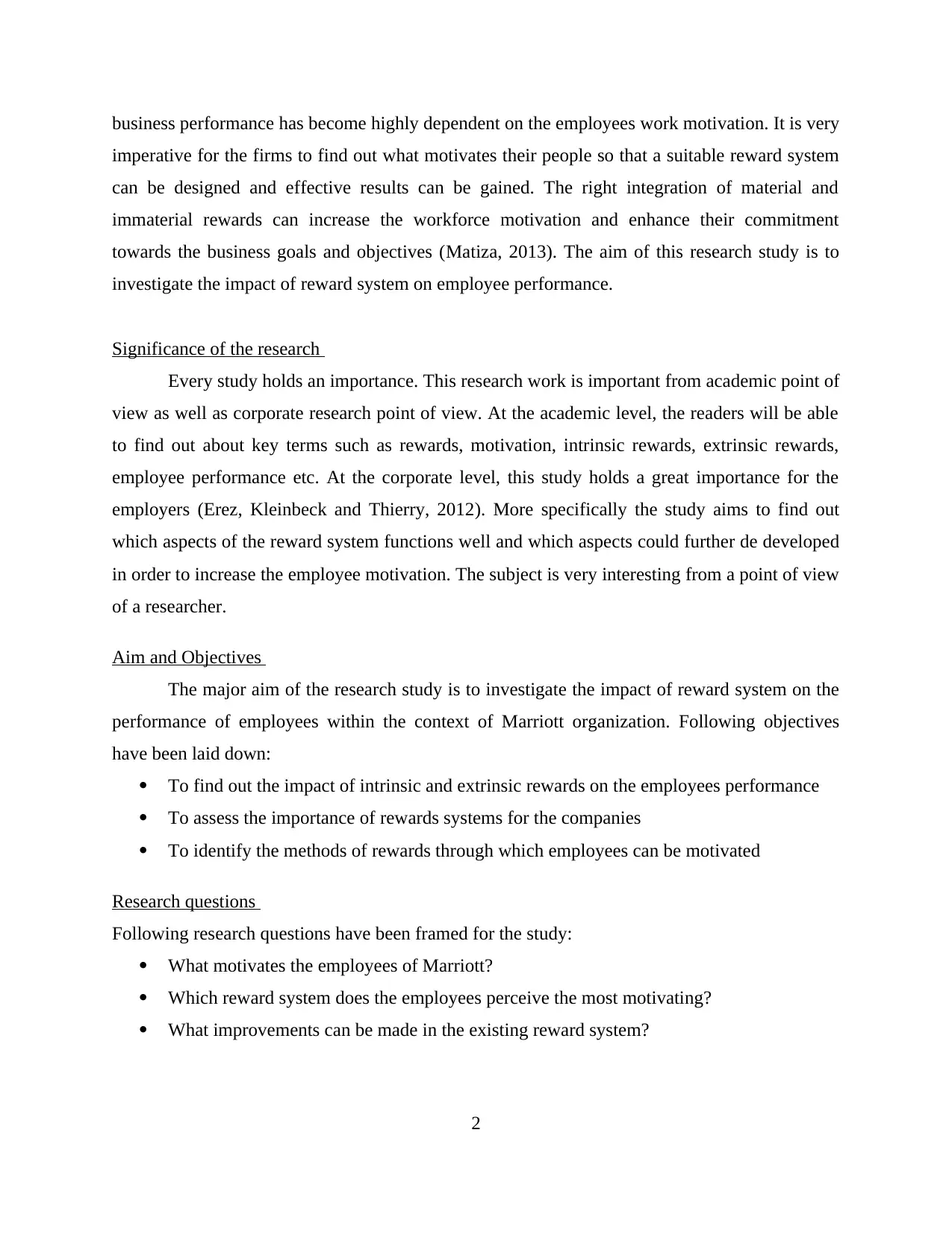
business performance has become highly dependent on the employees work motivation. It is very
imperative for the firms to find out what motivates their people so that a suitable reward system
can be designed and effective results can be gained. The right integration of material and
immaterial rewards can increase the workforce motivation and enhance their commitment
towards the business goals and objectives (Matiza, 2013). The aim of this research study is to
investigate the impact of reward system on employee performance.
Significance of the research
Every study holds an importance. This research work is important from academic point of
view as well as corporate research point of view. At the academic level, the readers will be able
to find out about key terms such as rewards, motivation, intrinsic rewards, extrinsic rewards,
employee performance etc. At the corporate level, this study holds a great importance for the
employers (Erez, Kleinbeck and Thierry, 2012). More specifically the study aims to find out
which aspects of the reward system functions well and which aspects could further de developed
in order to increase the employee motivation. The subject is very interesting from a point of view
of a researcher.
Aim and Objectives
The major aim of the research study is to investigate the impact of reward system on the
performance of employees within the context of Marriott organization. Following objectives
have been laid down:
To find out the impact of intrinsic and extrinsic rewards on the employees performance
To assess the importance of rewards systems for the companies
To identify the methods of rewards through which employees can be motivated
Research questions
Following research questions have been framed for the study:
What motivates the employees of Marriott?
Which reward system does the employees perceive the most motivating?
What improvements can be made in the existing reward system?
2
imperative for the firms to find out what motivates their people so that a suitable reward system
can be designed and effective results can be gained. The right integration of material and
immaterial rewards can increase the workforce motivation and enhance their commitment
towards the business goals and objectives (Matiza, 2013). The aim of this research study is to
investigate the impact of reward system on employee performance.
Significance of the research
Every study holds an importance. This research work is important from academic point of
view as well as corporate research point of view. At the academic level, the readers will be able
to find out about key terms such as rewards, motivation, intrinsic rewards, extrinsic rewards,
employee performance etc. At the corporate level, this study holds a great importance for the
employers (Erez, Kleinbeck and Thierry, 2012). More specifically the study aims to find out
which aspects of the reward system functions well and which aspects could further de developed
in order to increase the employee motivation. The subject is very interesting from a point of view
of a researcher.
Aim and Objectives
The major aim of the research study is to investigate the impact of reward system on the
performance of employees within the context of Marriott organization. Following objectives
have been laid down:
To find out the impact of intrinsic and extrinsic rewards on the employees performance
To assess the importance of rewards systems for the companies
To identify the methods of rewards through which employees can be motivated
Research questions
Following research questions have been framed for the study:
What motivates the employees of Marriott?
Which reward system does the employees perceive the most motivating?
What improvements can be made in the existing reward system?
2
Paraphrase This Document
Need a fresh take? Get an instant paraphrase of this document with our AI Paraphraser
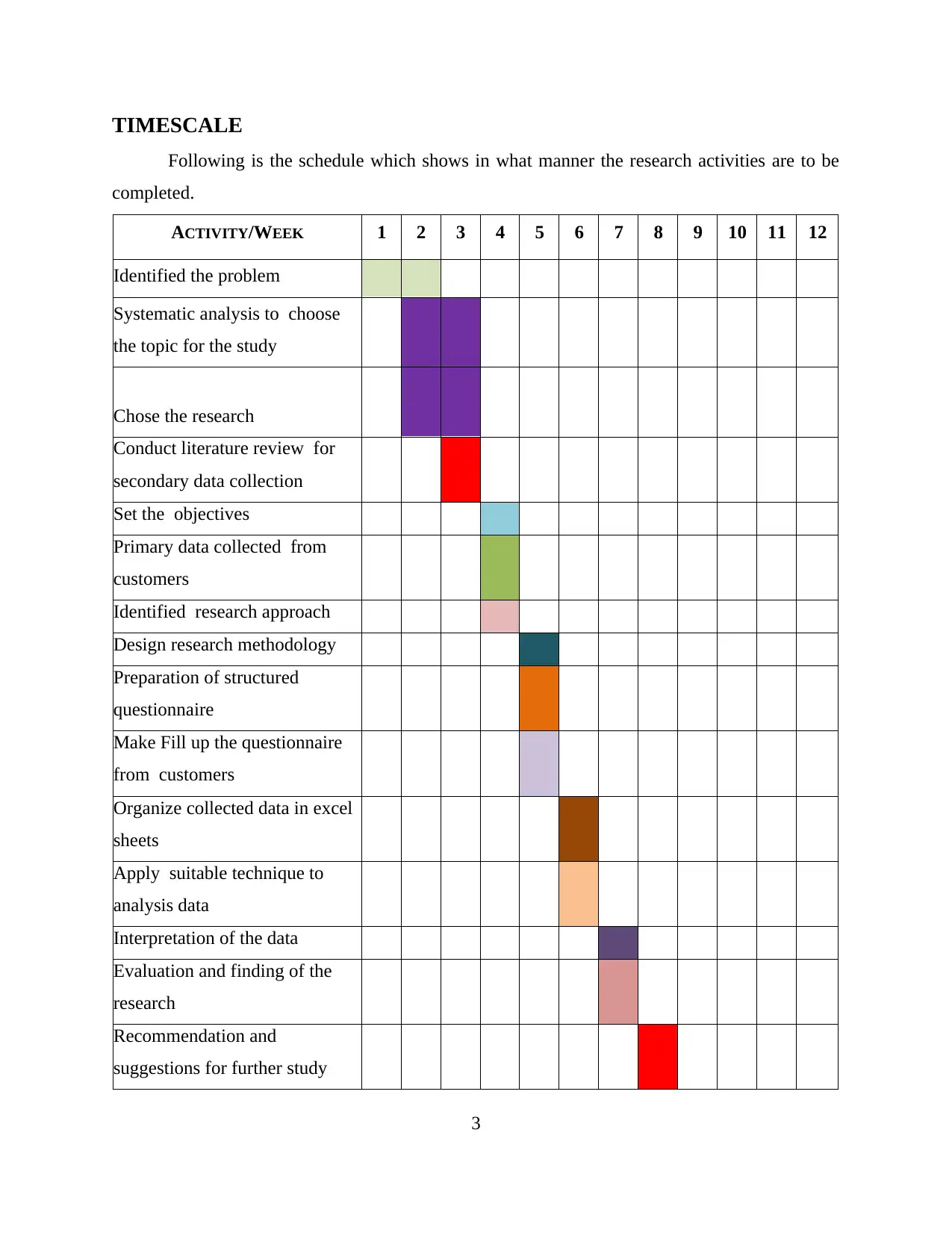
TIMESCALE
Following is the schedule which shows in what manner the research activities are to be
completed.
ACTIVITY/WEEK 1 2 3 4 5 6 7 8 9 10 11 12
Identified the problem
Systematic analysis to choose
the topic for the study
Chose the research
Conduct literature review for
secondary data collection
Set the objectives
Primary data collected from
customers
Identified research approach
Design research methodology
Preparation of structured
questionnaire
Make Fill up the questionnaire
from customers
Organize collected data in excel
sheets
Apply suitable technique to
analysis data
Interpretation of the data
Evaluation and finding of the
research
Recommendation and
suggestions for further study
3
Following is the schedule which shows in what manner the research activities are to be
completed.
ACTIVITY/WEEK 1 2 3 4 5 6 7 8 9 10 11 12
Identified the problem
Systematic analysis to choose
the topic for the study
Chose the research
Conduct literature review for
secondary data collection
Set the objectives
Primary data collected from
customers
Identified research approach
Design research methodology
Preparation of structured
questionnaire
Make Fill up the questionnaire
from customers
Organize collected data in excel
sheets
Apply suitable technique to
analysis data
Interpretation of the data
Evaluation and finding of the
research
Recommendation and
suggestions for further study
3
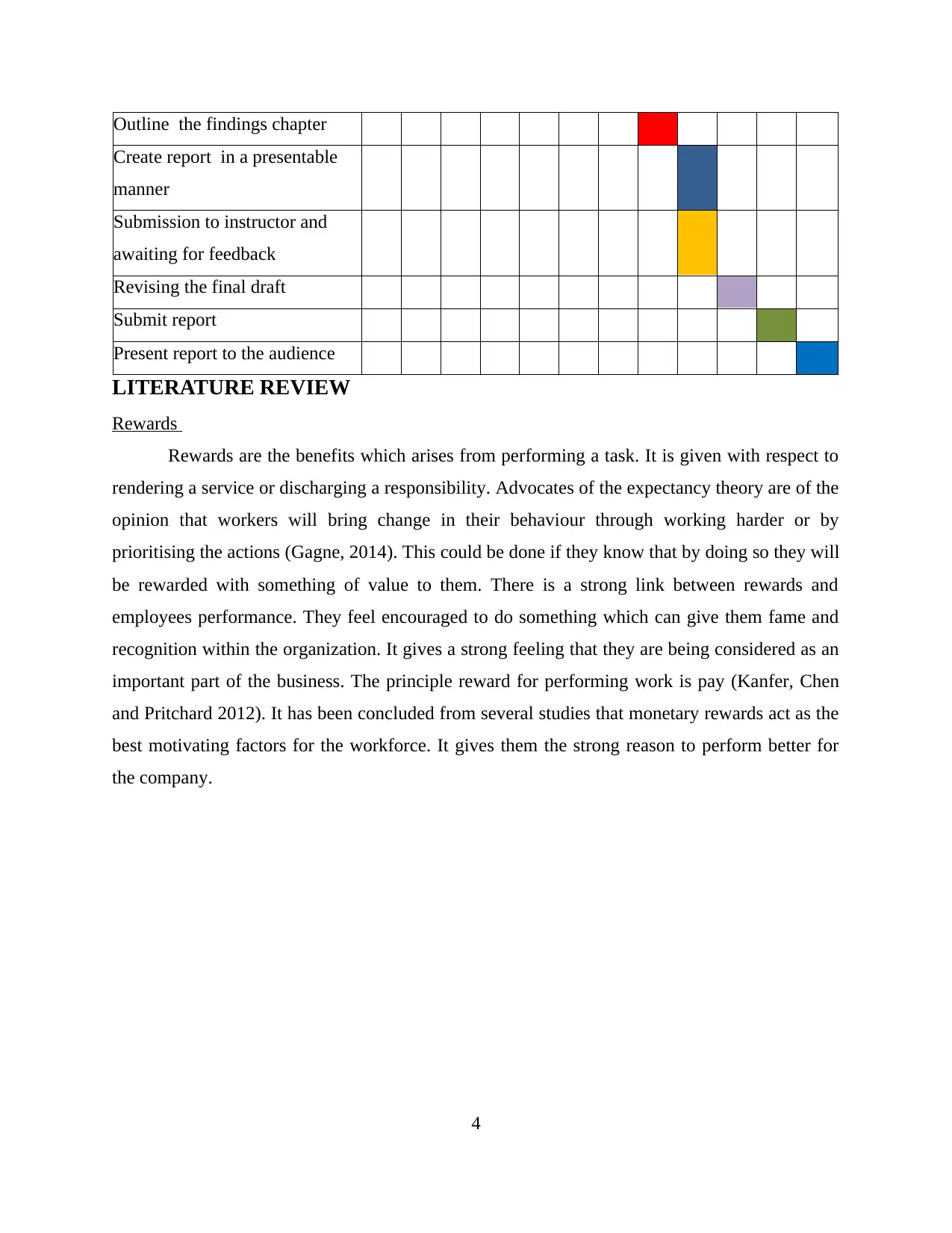
Outline the findings chapter
Create report in a presentable
manner
Submission to instructor and
awaiting for feedback
Revising the final draft
Submit report
Present report to the audience
LITERATURE REVIEW
Rewards
Rewards are the benefits which arises from performing a task. It is given with respect to
rendering a service or discharging a responsibility. Advocates of the expectancy theory are of the
opinion that workers will bring change in their behaviour through working harder or by
prioritising the actions (Gagne, 2014). This could be done if they know that by doing so they will
be rewarded with something of value to them. There is a strong link between rewards and
employees performance. They feel encouraged to do something which can give them fame and
recognition within the organization. It gives a strong feeling that they are being considered as an
important part of the business. The principle reward for performing work is pay (Kanfer, Chen
and Pritchard 2012). It has been concluded from several studies that monetary rewards act as the
best motivating factors for the workforce. It gives them the strong reason to perform better for
the company.
4
Create report in a presentable
manner
Submission to instructor and
awaiting for feedback
Revising the final draft
Submit report
Present report to the audience
LITERATURE REVIEW
Rewards
Rewards are the benefits which arises from performing a task. It is given with respect to
rendering a service or discharging a responsibility. Advocates of the expectancy theory are of the
opinion that workers will bring change in their behaviour through working harder or by
prioritising the actions (Gagne, 2014). This could be done if they know that by doing so they will
be rewarded with something of value to them. There is a strong link between rewards and
employees performance. They feel encouraged to do something which can give them fame and
recognition within the organization. It gives a strong feeling that they are being considered as an
important part of the business. The principle reward for performing work is pay (Kanfer, Chen
and Pritchard 2012). It has been concluded from several studies that monetary rewards act as the
best motivating factors for the workforce. It gives them the strong reason to perform better for
the company.
4
⊘ This is a preview!⊘
Do you want full access?
Subscribe today to unlock all pages.

Trusted by 1+ million students worldwide
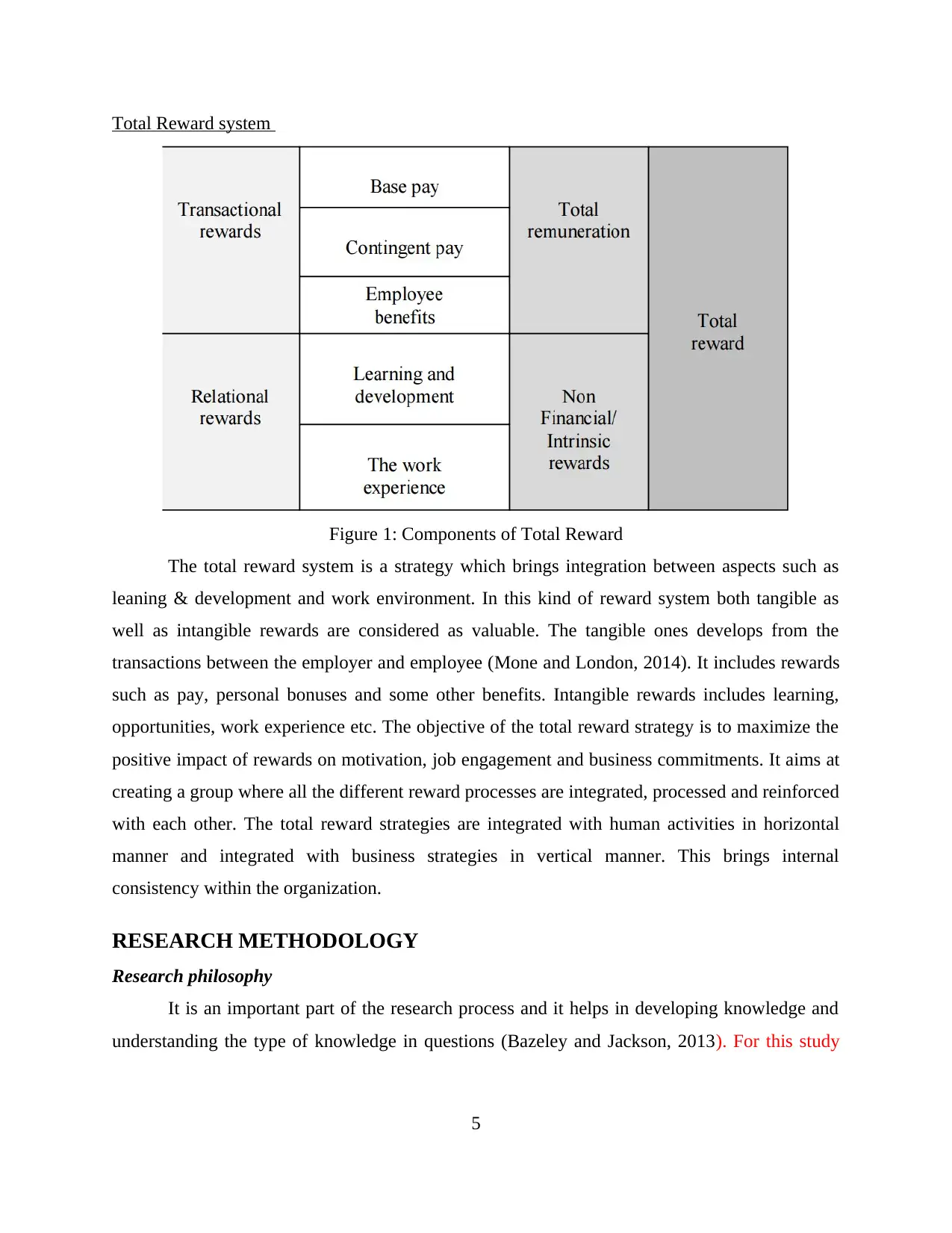
Total Reward system
Figure 1: Components of Total Reward
The total reward system is a strategy which brings integration between aspects such as
leaning & development and work environment. In this kind of reward system both tangible as
well as intangible rewards are considered as valuable. The tangible ones develops from the
transactions between the employer and employee (Mone and London, 2014). It includes rewards
such as pay, personal bonuses and some other benefits. Intangible rewards includes learning,
opportunities, work experience etc. The objective of the total reward strategy is to maximize the
positive impact of rewards on motivation, job engagement and business commitments. It aims at
creating a group where all the different reward processes are integrated, processed and reinforced
with each other. The total reward strategies are integrated with human activities in horizontal
manner and integrated with business strategies in vertical manner. This brings internal
consistency within the organization.
RESEARCH METHODOLOGY
Research philosophy
It is an important part of the research process and it helps in developing knowledge and
understanding the type of knowledge in questions (Bazeley and Jackson, 2013). For this study
5
Figure 1: Components of Total Reward
The total reward system is a strategy which brings integration between aspects such as
leaning & development and work environment. In this kind of reward system both tangible as
well as intangible rewards are considered as valuable. The tangible ones develops from the
transactions between the employer and employee (Mone and London, 2014). It includes rewards
such as pay, personal bonuses and some other benefits. Intangible rewards includes learning,
opportunities, work experience etc. The objective of the total reward strategy is to maximize the
positive impact of rewards on motivation, job engagement and business commitments. It aims at
creating a group where all the different reward processes are integrated, processed and reinforced
with each other. The total reward strategies are integrated with human activities in horizontal
manner and integrated with business strategies in vertical manner. This brings internal
consistency within the organization.
RESEARCH METHODOLOGY
Research philosophy
It is an important part of the research process and it helps in developing knowledge and
understanding the type of knowledge in questions (Bazeley and Jackson, 2013). For this study
5
Paraphrase This Document
Need a fresh take? Get an instant paraphrase of this document with our AI Paraphraser
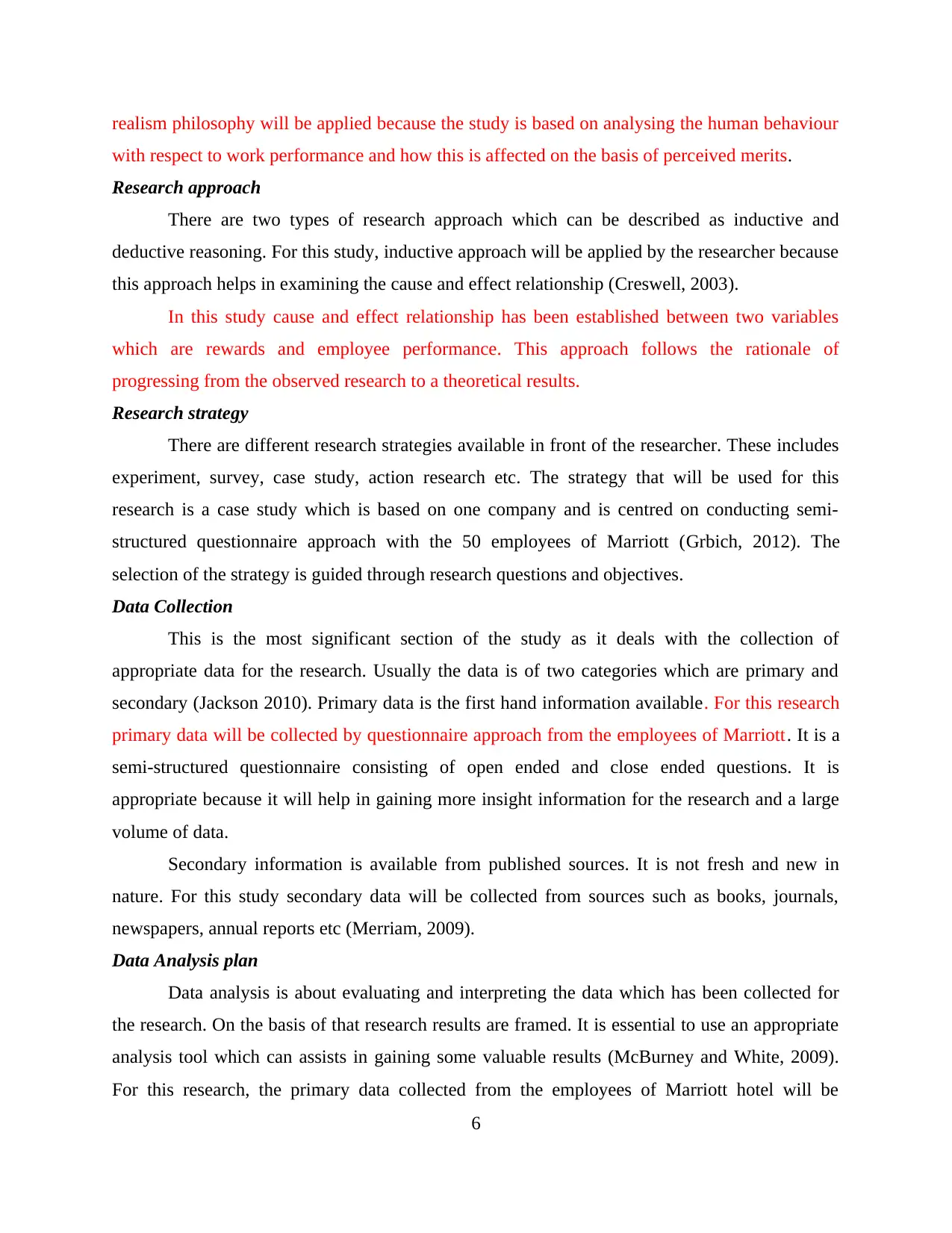
realism philosophy will be applied because the study is based on analysing the human behaviour
with respect to work performance and how this is affected on the basis of perceived merits.
Research approach
There are two types of research approach which can be described as inductive and
deductive reasoning. For this study, inductive approach will be applied by the researcher because
this approach helps in examining the cause and effect relationship (Creswell, 2003).
In this study cause and effect relationship has been established between two variables
which are rewards and employee performance. This approach follows the rationale of
progressing from the observed research to a theoretical results.
Research strategy
There are different research strategies available in front of the researcher. These includes
experiment, survey, case study, action research etc. The strategy that will be used for this
research is a case study which is based on one company and is centred on conducting semi-
structured questionnaire approach with the 50 employees of Marriott (Grbich, 2012). The
selection of the strategy is guided through research questions and objectives.
Data Collection
This is the most significant section of the study as it deals with the collection of
appropriate data for the research. Usually the data is of two categories which are primary and
secondary (Jackson 2010). Primary data is the first hand information available. For this research
primary data will be collected by questionnaire approach from the employees of Marriott. It is a
semi-structured questionnaire consisting of open ended and close ended questions. It is
appropriate because it will help in gaining more insight information for the research and a large
volume of data.
Secondary information is available from published sources. It is not fresh and new in
nature. For this study secondary data will be collected from sources such as books, journals,
newspapers, annual reports etc (Merriam, 2009).
Data Analysis plan
Data analysis is about evaluating and interpreting the data which has been collected for
the research. On the basis of that research results are framed. It is essential to use an appropriate
analysis tool which can assists in gaining some valuable results (McBurney and White, 2009).
For this research, the primary data collected from the employees of Marriott hotel will be
6
with respect to work performance and how this is affected on the basis of perceived merits.
Research approach
There are two types of research approach which can be described as inductive and
deductive reasoning. For this study, inductive approach will be applied by the researcher because
this approach helps in examining the cause and effect relationship (Creswell, 2003).
In this study cause and effect relationship has been established between two variables
which are rewards and employee performance. This approach follows the rationale of
progressing from the observed research to a theoretical results.
Research strategy
There are different research strategies available in front of the researcher. These includes
experiment, survey, case study, action research etc. The strategy that will be used for this
research is a case study which is based on one company and is centred on conducting semi-
structured questionnaire approach with the 50 employees of Marriott (Grbich, 2012). The
selection of the strategy is guided through research questions and objectives.
Data Collection
This is the most significant section of the study as it deals with the collection of
appropriate data for the research. Usually the data is of two categories which are primary and
secondary (Jackson 2010). Primary data is the first hand information available. For this research
primary data will be collected by questionnaire approach from the employees of Marriott. It is a
semi-structured questionnaire consisting of open ended and close ended questions. It is
appropriate because it will help in gaining more insight information for the research and a large
volume of data.
Secondary information is available from published sources. It is not fresh and new in
nature. For this study secondary data will be collected from sources such as books, journals,
newspapers, annual reports etc (Merriam, 2009).
Data Analysis plan
Data analysis is about evaluating and interpreting the data which has been collected for
the research. On the basis of that research results are framed. It is essential to use an appropriate
analysis tool which can assists in gaining some valuable results (McBurney and White, 2009).
For this research, the primary data collected from the employees of Marriott hotel will be
6
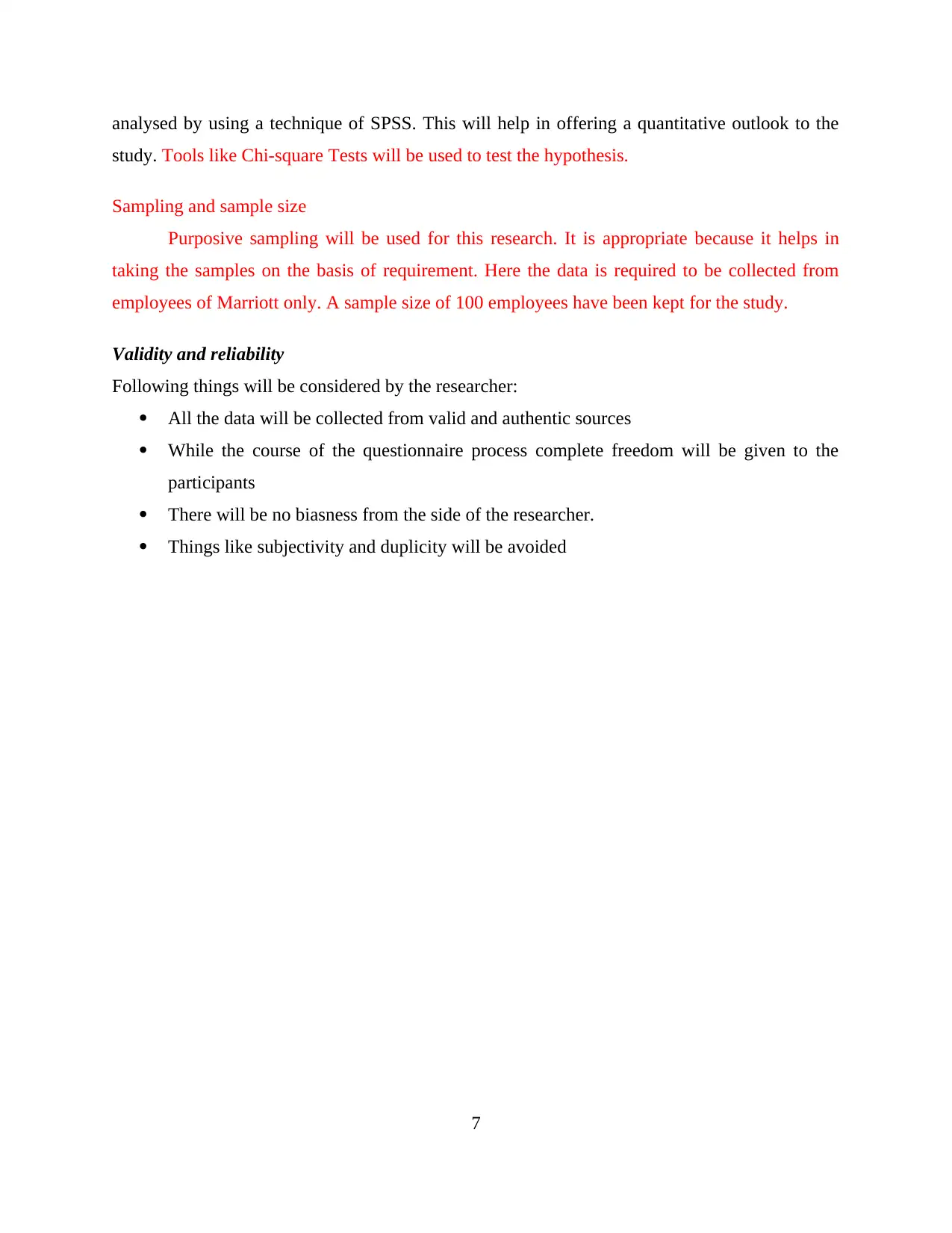
analysed by using a technique of SPSS. This will help in offering a quantitative outlook to the
study. Tools like Chi-square Tests will be used to test the hypothesis.
Sampling and sample size
Purposive sampling will be used for this research. It is appropriate because it helps in
taking the samples on the basis of requirement. Here the data is required to be collected from
employees of Marriott only. A sample size of 100 employees have been kept for the study.
Validity and reliability
Following things will be considered by the researcher:
All the data will be collected from valid and authentic sources
While the course of the questionnaire process complete freedom will be given to the
participants
There will be no biasness from the side of the researcher.
Things like subjectivity and duplicity will be avoided
7
study. Tools like Chi-square Tests will be used to test the hypothesis.
Sampling and sample size
Purposive sampling will be used for this research. It is appropriate because it helps in
taking the samples on the basis of requirement. Here the data is required to be collected from
employees of Marriott only. A sample size of 100 employees have been kept for the study.
Validity and reliability
Following things will be considered by the researcher:
All the data will be collected from valid and authentic sources
While the course of the questionnaire process complete freedom will be given to the
participants
There will be no biasness from the side of the researcher.
Things like subjectivity and duplicity will be avoided
7
⊘ This is a preview!⊘
Do you want full access?
Subscribe today to unlock all pages.

Trusted by 1+ million students worldwide
1 out of 9
Related Documents
Your All-in-One AI-Powered Toolkit for Academic Success.
+13062052269
info@desklib.com
Available 24*7 on WhatsApp / Email
![[object Object]](/_next/static/media/star-bottom.7253800d.svg)
Unlock your academic potential
Copyright © 2020–2025 A2Z Services. All Rights Reserved. Developed and managed by ZUCOL.





